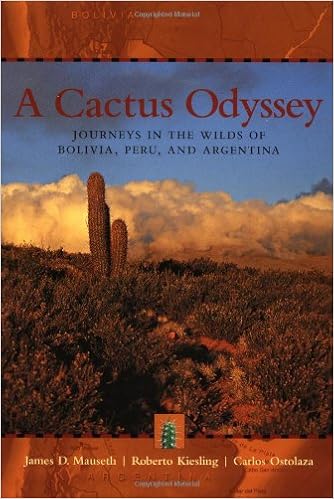
By James D. Mauseth
This e-book offers the tales of 3 avid box biologists who over the process 15 years usually traveled jointly looking for cacti in Bolivia, Peru, and Argentina. The conversational sort of this travelogue permits us to proportion within the authors' pleasure as they come across vegetation that experience hardly, if ever, been written approximately. approximately 195 notable colour images accompany the vibrant descriptions of surprising cacti starting to be along non-succulent crops, at altitudes of 8000 ft or more-and even in rainforests! A Cactus Odyssey will curiosity gardeners, tourists, and conservationists from world wide who desire to examine extra approximately those impossible to resist vegetation, and it's the desire of the authors that this booklet will encourage others to adopt their very own cactus odyssey.
Read or Download A Cactus Odyssey: Journeys in the Wilds of Bolivia, Peru, and Argentina PDF
Similar plants books
Seed development and germination
This article is meant for plant physiologists, molecular biologists, biochemists, biotechnologists, geneticists, horticulturalists, agromnomists and botanists, and upper-level undergraduate and graduate scholars in those disciplines. It integrates advances within the different and rapidly-expanding box of seed technological know-how, from ecological and demographic points of seed construction, dispersal and germination, to the molecular biology of seed improvement.
In 1958 E. BUNNING released a booklet within the former sequence "Proto plasmatologia" entitled "Polaritat und inaquale Teilung des pflanzlichen Protoplasten" (polarity and unequal department of the plant protoplast) within which for the 1st time result of experimental plant cytomorphogenesis have been re considered. This e-book was once established thoroughly on mild microscopic observations and relatively easy experimental strategies.
Cyclic Phenomena in Marine vegetation and Animals covers the complaints of the thirteenth ecu Marine Biology Symposium. The name offers papers that take on the cyclical organic approaches in inhabitants ecology, developmental biology, metabolism, and the habit of marine organisms. The textual content first covers themes in regards to the inhabitants cycles of natural world.
A country's imaginative and prescient for constructing renewable and sustainable strength assets is sometimes propelled through 3 very important drivers – safety, fee, and environmental influence. The U. S. presently bills for 1 / 4 of the world’s overall oil intake, with family calls for necessitating – at an ever transforming into fee – a web import of greater than 50% of the oil utilized in this nation.
- The Origins of Agriculture in the Lowland Neotropics
- The Cracking Tower: A Strategy for Transcending 2012
- Pleurocarpous Mosses: Systematics and Evolution
- Plastid Biology
- Thoreau’s Wildflowers
- References no. 2480 – 3686 / ACE-ZYA
Additional info for A Cactus Odyssey: Journeys in the Wilds of Bolivia, Peru, and Argentina
Sample text
Many cacti of humid coastal regions, such as those of Acanthocereus, Leptocereus, and Pereskia, have little succulence. Cacti in habitats that routinely have only one period of rain a year, on the other hand, must contain large amounts of succulent tissue, not enough to last merely a year, but enough in case there are two bad years in a row. Armatocerei, copi- Cacti: Introduction, Biology, and History 15 apoas, and soehrensias survive years without rain, relying on their abundance of stored water.
Perhaps cacti cannot transpire rapidly enough to keep themselves cool because they do not have enough water. forests (“tropical” indicates that it never freezes), and rarely in temperate ones (where freezes occur at least occasionally). There are many temperate rainforests in the Americas, but few have epiphytic cacti. Of the rainforest cacti, Selenicereus seems among the most hardy, some plants surviving even mild freezing conditions in cultivation. The number of cacti adapted to cold, high alpine conditions is surprisingly large.
Individuals of Echinopsis also grow among the bromeliads, and several plants of Cereus have taken root where clefts in the rock are wide enough. place. They are delicate, even fragile, and because we have seen them only as houseplants, it seems incongruous that here they are surrounded by cactus and rock. During a sunny summer day, the heat must be incredible, yet the plants survive. The begonias are obviously healthy and happy, and so beautiful that we do not mind that we have not found any new cacti up here.



